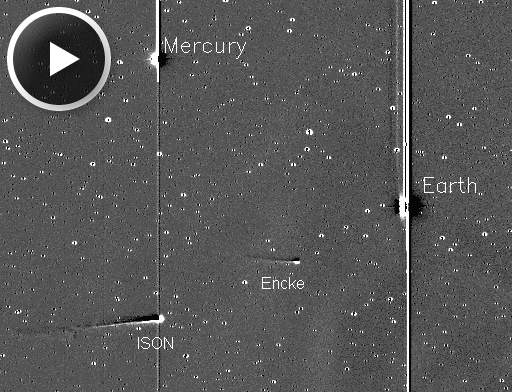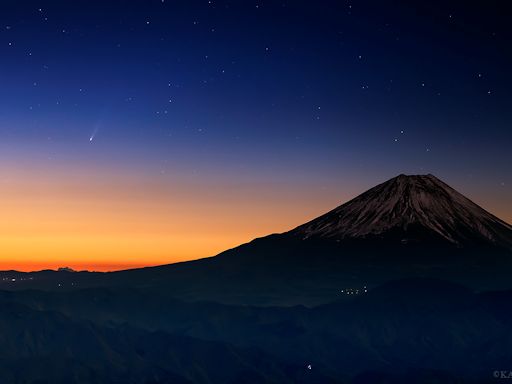CHANCE OF FLARES: NOAA forecasters estimate a 25% chance of M-class solar flares today. The most likely blast-sites (sunspots AR1904 and AR1905) are not, however, facing Earth. Any eruptions this weekend will probably miss our planet. Solar flare alerts: text, voice
COMETS IN THE SOLAR WIND: NASA's STEREO-A spacecraft is monitoring Comet ISON as it approaches the sun for a close encounter on Nov. 28th. The latest movie from the spacecraft's Heliospheric Imager captures not only Comet ISON but also Earth, Mercury, and Comet Encke. Click to set the scene in motion:
In the movie, which spans a two+ day period from Nov. 20 to Nov. 22, the sun is to the right, off-screen. "The dark 'clouds' coming from that direction are density enhancements in the solar wind, and these are what are causing the ripples you see in the comet tails," explains Karl Battams of NASA's Comet ISON Observing Campaign.
Although the two comets seem to be experiencing the same solar wind, their tails ripple differently. "Encke has kind of long waves in the tail, whereas ISON's seems almost like high-frequency puffs," points out Battams.
Appearances notwithstanding, the two comets might be in two different streams of solar wind. "The most likely explanation is that ISON is in a faster stream," he comntinues. "Imagine holding a flag on a slightly breezy day. The flag will waft gently in the breeze. Now imagine holding it in really strong winds. The flag will be rippling violently, but those ripples will be smaller in amplitude."
Battams also suggests a second, more speculative possibility. You can read about it here.
Realtime Comet ISON Photo Gallery
COMET ISON, T-4 DAYS: Comet ISON is now only 4 days from perihelion. On Nov, 28th, Thanksgiving Day in the USA, it will fly through the sun's atmosphere little more than a million kilometers above the surface of the sun. At closest approach, the temperature of ISON's core could rise as high as 5000o Fahrenheit--an existential challenge for an icy comet. No one knows if it will survive. As the "final countdown" ticks to zero, photographers are taking some marvelous parting shots. Here is Comet ISON plunging into the sunrise beside Mt. Fuji on Nov. 22nd:
Japanese photographer Kagaya took the picture using a Canon EOS 1D C digital camera. "This is a 3-second exposure at ISO 2000," he says. In the full-sized image, you can also see Mercury hovering to the left of the comet.
For more unique images of Comet ISON, including a daytime shot from Los Angeles and a conjunction with the Temple of Poseidon in Greece, browse the realtime photo gallery:

Solar wind
speed: 321.5 km/sec
density: 1.2 protons/cm3
explanation | more data
Updated: Today at 1847 UT
X-ray Solar Flares
6-hr max: C3 1527 UT Nov24
24-hr: C4 0752 UT Nov24
explanation | more data
Updated: Today at: 1800 UT
![]()
Daily Sun: 24 Nov 13
Sunspots AR1904 and AR1905 have 'beta-gamma' magnetic fields that harbor energy for M-class solar flares. Neither sunspot, however, is facing Earth. Credit: SDO/HMI
![]()
Sunspot number: 65
What is the sunspot number?
Updated 24 Nov 2013
Spotless Days
Current Stretch: 0 days
2013 total: 0 days (0%)
2012 total: 0 days (0%)
2011 total: 2 days (<1%)
2010 total: 51 days (14%)
2009 total: 260 days (71%)
Since 2004: 821 days
Typical Solar Min: 486 days
Update 24 Nov 2013
The Radio Sun
10.7 cm flux: 143 sfu
explanation | more data
Updated 24 Nov 2013
![]()
Current Auroral Oval:
Switch to: Europe, USA, New Zealand, Antarctica
Credit: NOAA/POES
![]()
Planetary K-index
Now: Kp= 0 quiet
24-hr max: Kp= 1 quiet
explanation | more data
Interplanetary Mag. Field
Btotal: 3.6 nT
Bz: 2 nT south
explanation | more data
Updated: Today at 1846 UT
![]()
Coronal Holes: 24 Nov 13
There are no large coronal holes on the Earthside of the sun. Credit: SDO/AIA.






